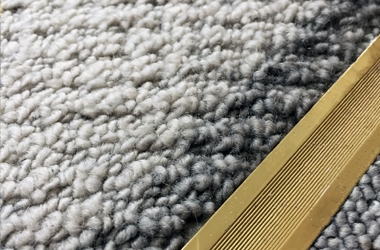How to remove filtration soiling from carpets
Filtration soiling, also known as carpet filtration or filtration lines are the dark, greyish lines that can be found on carpet in doorways, on the sides of stairs and along skirting boards.
This type of soiling can happen gradually over the years or can quickly develop over the period of a couple of months. Often mistaken for mould or the sign that a carpet is of low quality, dirty dark edges of carpet can occur in the even the most regularly cleaned environments fitted with the most expensive carpet and is not necessarily a sign of poor hygiene or rot.
What is filtration soiling?
Filtration soiling is not a carpet defect, nor the sign of mould. It is actually caused by airborne pollutants that accumulate on the carpet fibres in areas of concentrated airflow.
When air flows through a building, it will mostly escape through ventilation systems, windows and doors, but in the case of poor ventilation in more closed spaces air will escape through any gaps including under doorways, skirting boards, through floor boards and any holes in your carpet.
As the air filters through your carpet, any pollutants carried in it get trapped in the carpet fibres to create those dark, grey/black soil lines which look like a combination of dust and soot.
The level of soiling can depend on the level of pollutants in the air, as well as the volume of airflow. Who would've thought that the largest air filter in any building is the carpet, upholstery and carpet!
Pollutants in the air that significantly contribute to the problem include smoke from cigarettes and soot from burning candles and open fireplaces/log burners as well as cooking oils and dust.
How to clean and prevent carpet filtration soiling
Prevention is the most desirable option: The first step to preventing filtration soiling is to reduce the number of pollutants you’re releasing into the atmosphere. Stop burning candles as they produce a lot of dark soot. If you use a log burner or open fireplace, think about reducing how often you use it, and when you do, make sure the room is well ventilated and vacuum the surrounding floor after each use. If you smoke indoors, stop. Not only is this terrible for your health but it also contributes significantly to lingering odours and filtration lines. Another tip is to stop excessive use of aerosols and sprays and to make sure you dust regularly.
Another great tip for preventing filtration soiling is to check your ventilation and ensure your building has sufficient airflow. This can be done by leaving doors open to allow air to circulate more freely, by draft proofing/gap filling and by ensuring any ventilation system filters are clean and clear.
If however you do have carpet filtration lines don’t worry, in most cases there is no need to remove the carpet and instead the correct cleaning procedure will help to reduce the appearance of the soiling.
First of all, as this type of soiling consists of millions of microscopic particles embedded deep within carpet fibres simply rubbing with a damp cloth and detergent will do very little and often make the situation worse by leaving a sticky residue that will attract more particles.
One of the best courses of action we recommend is a dry carpet cleaning treatment used with a pre-treatment to lift embedded soiling.
A pre-treatment, such as PRO43 Envirodri Carpet pre-Treatment contains unique soil suspension agents, designed to target soiling which will loosen pollutants from the carpet fibres.
Using this alongside a dry carpet cleaning compound, like PRO40 Envirodri Microsponges ensure that embedded soiling is absorbed and lifted from the carpet in a controlled manner. This is then vacuumed away leaving the carpets dry and free from any sticky residues and contaminates. This is preferential to wet cleaning, as by introducing water, the pollutants can soak further into the carpet fibres and into the underlay to then re-appear a lot darker once dry.
Depending on the level of soiling this may remove most of the filtration soiling on the first attempt, or it may take several. As always, we strongly advise discussing any carpet filtration soiling with a professional before attempting a clean and only ever allow a fully trained operative to use cleaning equipment to ensure you get the best possible clean.



